DreamHack is where the gaming world comes to life. It’s a festival of play, competition, and community all under one roof. DreamHack added its first chess competition in 2025, held last weekend at its Dallas convention.
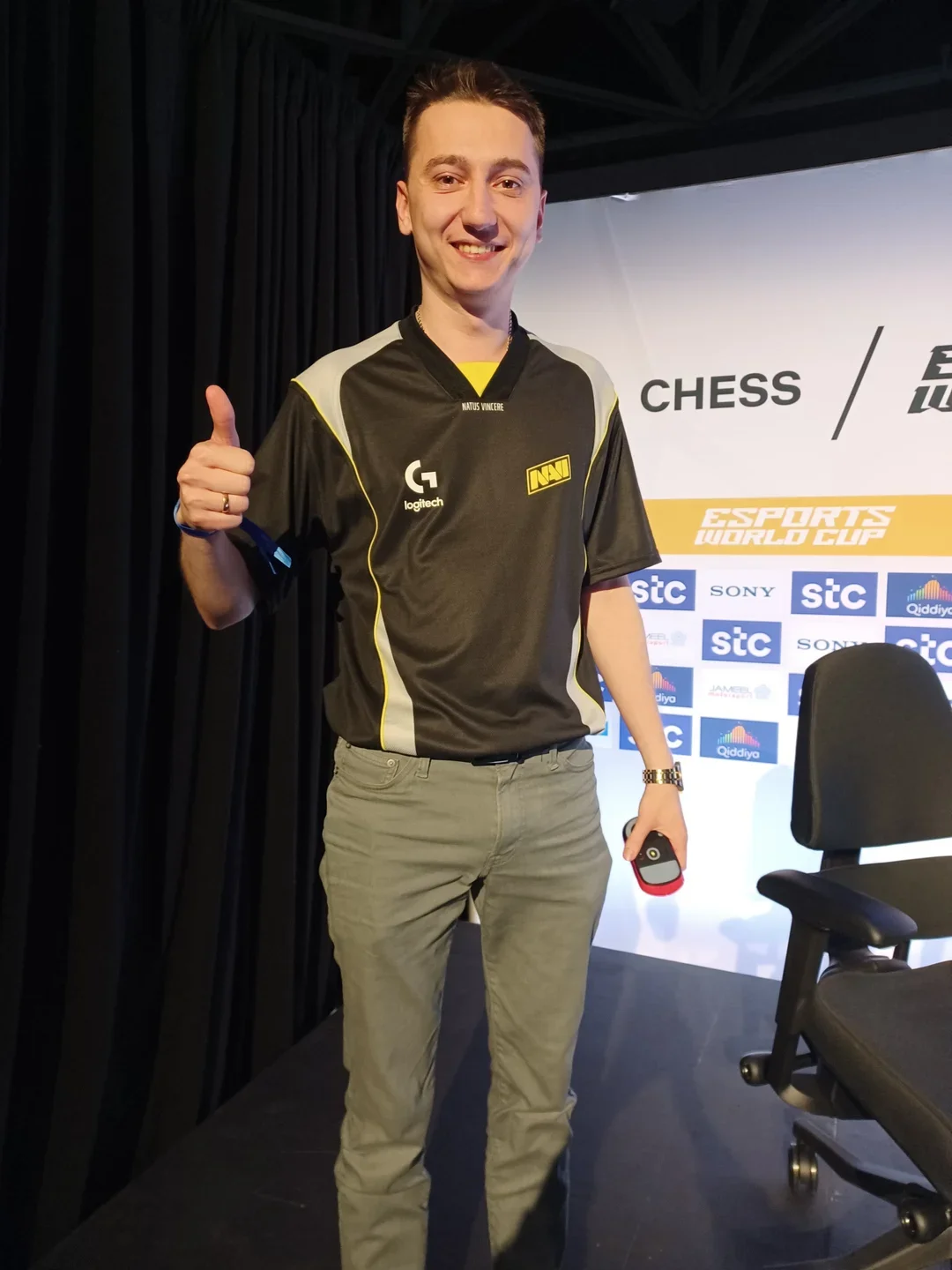
Ukrainian GM Oleksandr Bortnyk, a popular streamer and Charlotte Chess Center coach, won the $6,000 top prize after winning the playoffs. In addition to the $20,000 prize fund, the top four finishers also won flights to Riyadh, Saudi Arabia, and hotel accommodations to compete in the Last Chance Qualifiers (LCQ) at the Esports World Cup (EWC). Full standings from the weekend are available here, and more information about the format (and games) is covered below.
Play Louder. Together.
DreamHack Dallas was May 23–25 at the Kay Bailey Hutchison Convention Center. It attracted over 60,000 participants for esports tournaments and cosplay championships, as well as for music, gaming, and meet-and-greets with creators and personalities.
The motto of DreamHack is “Play Louder. Together,” but chess was a quiet part of DreamHack Dallas. Chess players wore noise-cancelling headphones during the games, played on Chess.com. Since the time control was game-in-10-minutes (no increment) with new rounds starting every 20 minutes, chess players did not have much time to talk. There was a 10-minute break after every three rounds, but during those breaks several players sprinted across the convention center to restrooms.
I wish that the organizer had set aside time for post mortems and socializing. In round 2, I drew realdominochris, who I think is Chris Authement. His profile lists winning the 2019 World Domino Championship. If this was Chris Authement, he has a US Chess rating of 1091 and lives in Baton Rouge, LA. At the start of DreamHack Dallas, his Chess.com Rapid rating was 1737. It would have been fun to analyze our game together. I’ve never met a World Domino Champion! But I did not know which computer he played on, so I never even saw him.
Format and Prizes
DreamHack Dallas divided chess players into four groups named A, B, C, and D. On Chess.com, those qualifiers are named, respectively, 1, 2, 3, and 4. Each player had their own DreamHack-provided computer.
During each qualifying group, four players played on computers on stage with excellent lighting. Everyone else played in partial darkness in what resembled a public library free-access computer area. The “top four” in each group are the players listed on Chess.com under their real names, rather than their user names. These spots went primarily to titled players registered by the original deadlines, with other spots distributed at the discretion of the organizers.
On Friday, May 23, Group A was at 1 p.m. and Group B began at 5 p.m. On Saturday, May 24, Group C was at 1 p.m. and Group D began at 5 p.m. The top two finishers from each group returned for the playoffs, which began at 10 a.m. on Sunday, May 25.
The top four playoff finishers won flights to Riyadh, and hotel accommodations, to play in the LCQ at the EWC. Additionally, EWC promised $20,000 in prize money at DreamHack Dallas, ranging from $6,000 for first place to $125 for tying for 13–16th places.
Chess Imbalances
A Chess.com article stated, “Players must complete an online registration by May 16 to participate.” Likewise, a May 2 email to selected US Chess members stated, “Important: To participate, players must register by May 16.”
Beginning May 8, Dimitri Cavalcanti, Senior Tournament Manager with eslfaceitgroup.com, emailed pre-registered players to confirm their participation. To confirm, each player had to attach a receipt showing a purchase of at least a one-day DreamHack Dallas ticket, which cost $49 not including sales tax or Tixr fees.
Tickets were non-refundable, but players didn’t know if they would be assigned a Friday or a Saturday qualifying group. This was stressful for players who obeyed the May 16th deadline. For example, my husband IM Doug Root works on Fridays. So, had he been assigned a Friday group, his ticket purchase would have gone to waste. We requested to play in one of the Saturday groups, but we didn’t know if our request would be honored.
On Wednesday, May 21, pre-registered DreamHack Dallas chess players learned their group assignments. Only 37 chess players had pre-registered as of that Wednesday, though promotional materials suggest that there was room for 256 players.
There were inequities in how DreamHack Dallas chess was run. First, despite the published May 16 deadline, players joined after May 16. In fact, players joined as late as the same day as their qualifier.
Second, that May 2 email sent to selected US Chess members stated, “Each qualifier is a 9-round Swiss.” A graphic that appeared on Chess.com’s webpages and social media also stated nine rounds:
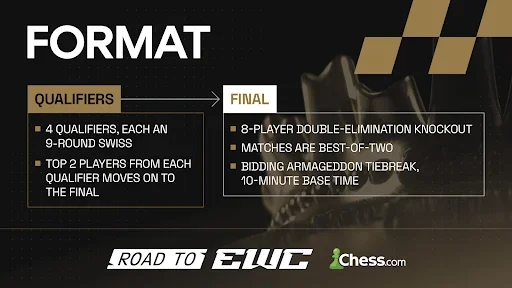
But Group A played 6 rounds, Group B played 5 rounds, and Groups C and D each played 9 rounds.
Third, the average rating of the top players was not balanced among the groups, as discussed in the “Qualifying Groups (Friday and Saturday)” section of this article.
Rules of Chess
Before DreamHack Dallas, I asked FIDE International Arbiter and US Chess National Tournament Director Judit Sztaray, who works for Chess.com, the rules questions in italics. When I could verify her answers on Chess.com’s website, I included them below.
Other questions are addressed in the seventh edition of the US Chess rulebook, “the only guide sanctioned and compiled by the US Chess Federation, the governing body for chess in the United States. It is designed as a reference for all chess players—but especially tournament chess players—and tournament directors.”
1) Does touch move apply?
Here is the touch-move rule from the US Chess rulebook:
A player on move who deliberately touches one or more pieces, in a manner that may reasonably be interpreted as the beginning of a move, must move or capture the first piece touched that can be moved or captured.
2) Is there lag?
While Chess.com has an article about lag, I didn’t know whether lag would occur at DreamHack Dallas.
3) Are pre-moves allowed?
While this Chess.com article tells how to set-up pre-moves, it doesn’t state whether tournaments allow this option. The page is fluid, “Updated over 3 months ago,” indicating that these rules may change.
US Chess tournament directors struggled, in a famous case from the U.S. Women’s Championship in 2008, with whether pre-moving was allowed in over-the-board time scrambles.
4) Equipment problems: What to do?
In a US Chess tournament, stopping the clock and finding the tournament director is recommended. Quoting the US Chess rulebook:
Stopping the clock. A player who wishes to make a claim of any sort or see a director for any legitimate reason may stop both sides of the clock before claiming and/or finding a director.
My husband IM Doug Root made a claim during the Group C qualifier about a malfunctioning organizer-provided mouse (see question 5 below). A couple hours after Doug played, GM Guillermo Vázquez sat at the same computer for the Group D qualifier. In a message about that computer’s mouse, Vázquez wrote, "the mouse gave me a bad impression and I used mine instead.”
5) Can you move by clicking the piece and then clicking the square you want it to move to? Or is dragging the piece the only option?
A Chess.com webpage claims that both options work, though it doesn’t specifically refer to tournament play. And the page is fluid, “Updated over 7 months ago,” indicating that these rules may change. The organizer-provided mouse that Doug used moved pieces correctly if squares were clicked but sometimes released pieces early with the “drag” method.
As White, Doug played 33. Rxc3, which is a normal move recapturing the queen. Doug had over three minutes, so there was no issue of a time scramble. The Stockfish evaluation of the position is plus 6.5 for White, because White is ahead by two minor pieces and a pawn. After 33. Rc2??, the move which appeared on Chess.com’s platform, Doug made a claim to the organizer. Doug could not stop his clock to make his claim so his time ran while the referee decided what to do. Doug’s claim was denied so then he resigned that game.
Regarding players’ in-game actions, the Chess.com website states:
Player Actions
All in-game actions, including but not limited to chess moves, pre-moves, promotions, draw offers, or resignations made by you will be deemed final. There will be no “takebacks“ due to actions unintentionally made by you for any reason. If you accidentally lose on time, that result will be deemed final
Insufficient Material
Unlike the US Chess rulebook, which defines terms, on Chess.com definitions of in-game actions have to be searched for on multiple pages. Searches yield separate, and unlinked, webpages on topics such as pre-moves, promotions, and draws.
One type of draw is insufficient material. This Chess.com article on insufficient material states, “Some of the above situations might be treated slightly differently in FIDE or USCF [sic] tournaments, or on other sites.” [USCF was rebranded as US Chess in 2015.]
In the first Grand Final game, GM Aleksei Sarana had a lone knight and one tenth of a second. (Editor’s note: Sarana’s name is spelled “Alexey” on his FIDE profile page, but he spells it “Aleksei” on his Chess.com profile.) When Bortnyk ran out of time, the Chess.com platform adjudicated the position as a “draw by timeout vs insufficient material.”
Chess.com Rulebook
US Chess and FIDE rules of chess differ from each other, as summarized here. An Esports Illustrated article stated, “Websites like Chess.com have standardized the sport” of chess. If that statement is true, then Chess.com should publish its rulebook for tournaments played on its platform.
I work for Chessable, which is part of Chess.com. I would love to edit or proofread a Chess.com rulebook. Currently, I am the Chessable Research Awards Coordinator.
Qualifying Groups (Friday and Saturday)
Saturday’s groups were almost two times bigger than Friday’s groups. Moreover, the average of the top five players’ Chess.com Rapid ratings in each Saturday group was higher than in each Friday group. I recorded the rating of each player before their group’s first round. I give players’ real names when those names are available in their profiles.
Group A average (Friday): 2227
- Oleksandr_Bortnyk: GM Oleksandr Bortnyk 2668
- nurmiTV: FM Teemu Virtanen 2343
- VishSB18: 2125
- ElliotAldersonTwitch: NM Shelev Oberoi 2000
- Mmmflatbread: GM Mark Heimann 1999
12 players participated in this group; the top five are listed above.
Group B average (Friday): 2299
- mishanick: GM Aleksei Sarana 2659
- Nakachuk: GM Rahul Srivatshav Peddi 2475
- A4RookA3: FM Lucius Mellilo 2266
- caterpillar_gang: 2125
- TrulyHumbledUnderGod: NM Alexander Heimann 1969
10 players participated in this group; the top five are listed above.
Group C average (Saturday): 2379
- Vaathi_Coming: GM Aravindh Chithambaram 2766
- DDRoot: IM Doug Root, who joined Chess.com so that he could play at DreamHack Dallas. His Rapid rating on the DreamHack roster was 2446, which is actually Doug’s FIDE rating as he had no prior Chess.com games.
- Pxl737: “Ruben from Texas” 2290
- JimGuarTV: 2217
- tan275: WIM Tarini Goyal 2174
21 players participated in this group; the top five are listed above.
Group D average (Saturday): 2412
- penguingm1: GM Andrew Tang 2600
- ekurtz: NM Eric Kurtz 2556
- gena217: GM Guillermo Vazquez 2543
- ajgreen: NM Austen Green 2250
- aYzz: Timothy Horng 2111
19 players participated in this group; the top five are listed above.
From Group A, the playoff qualifiers were NM Shelev Oberoi and GM Olexandr Bortnyk. Both scored 5 points out of 6 rounds. Oberoi attends Saint Louis University. Oberoi defeated Bortnyk in round 2 (annotated in Chess.com’s report) but lost to GM Mark Heimann in round 4. Heimann, who lost to Bortnyk in round 5 and drew FM Teemu Virtanen in round 2, did not qualify for the playoffs.
Sarana swept Group B, which was 5 rounds long, with a perfect 5/5 score. Tied for second were GM Rahul Srivatshav Peddi and NM Alexander Heimann, who both lost to Sarana but drew each other. Peddi, a graduate student in finance at The University of Texas at Dallas (UTD), advanced to the playoffs on tiebreak.
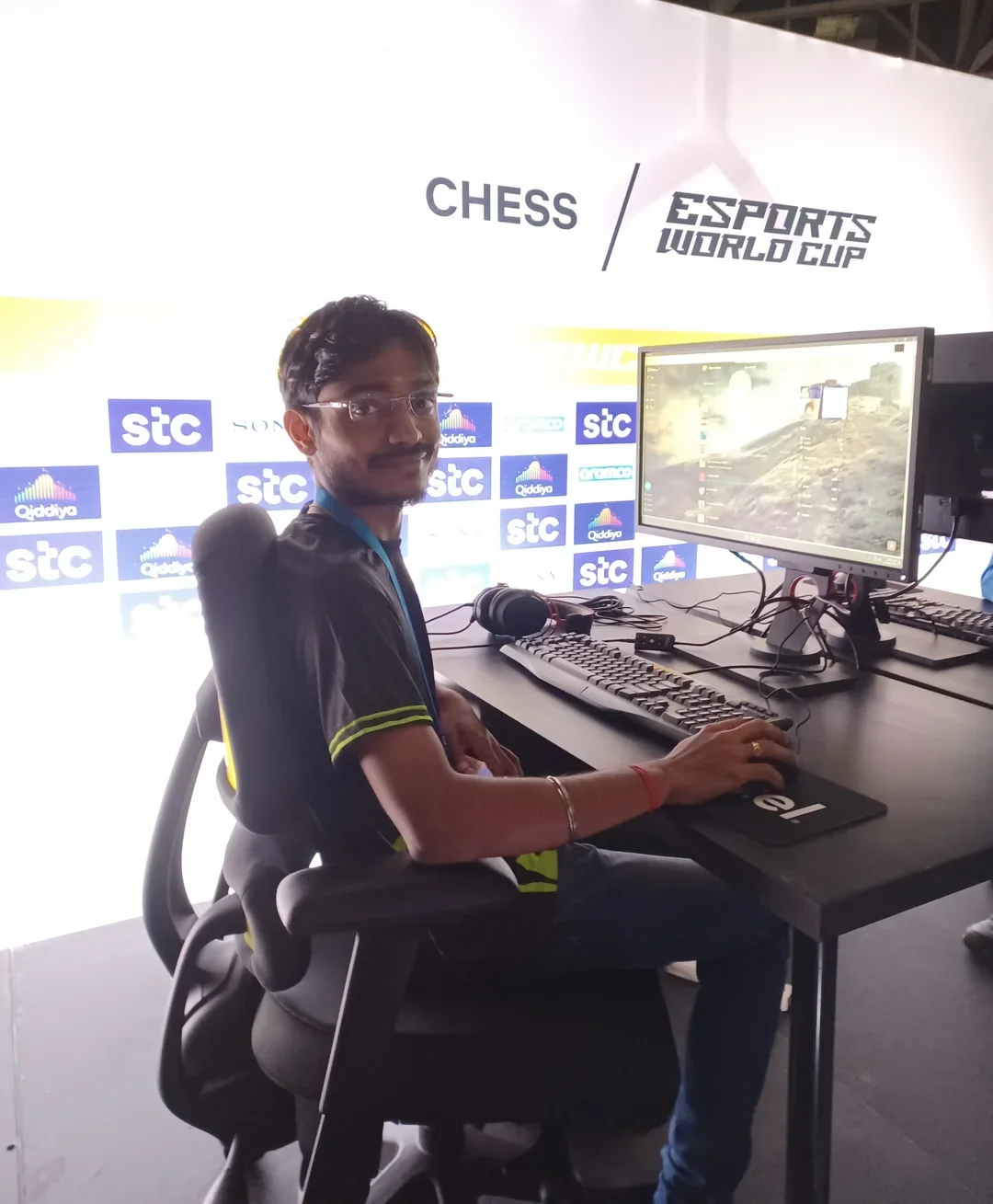
GM Aravindh Chithambaram swept Group C, which was nine rounds long, with a perfect 9/9 score. Second place, with 7 points, was WIM Tarini Goyal, who completed her MBA at UTD this spring.
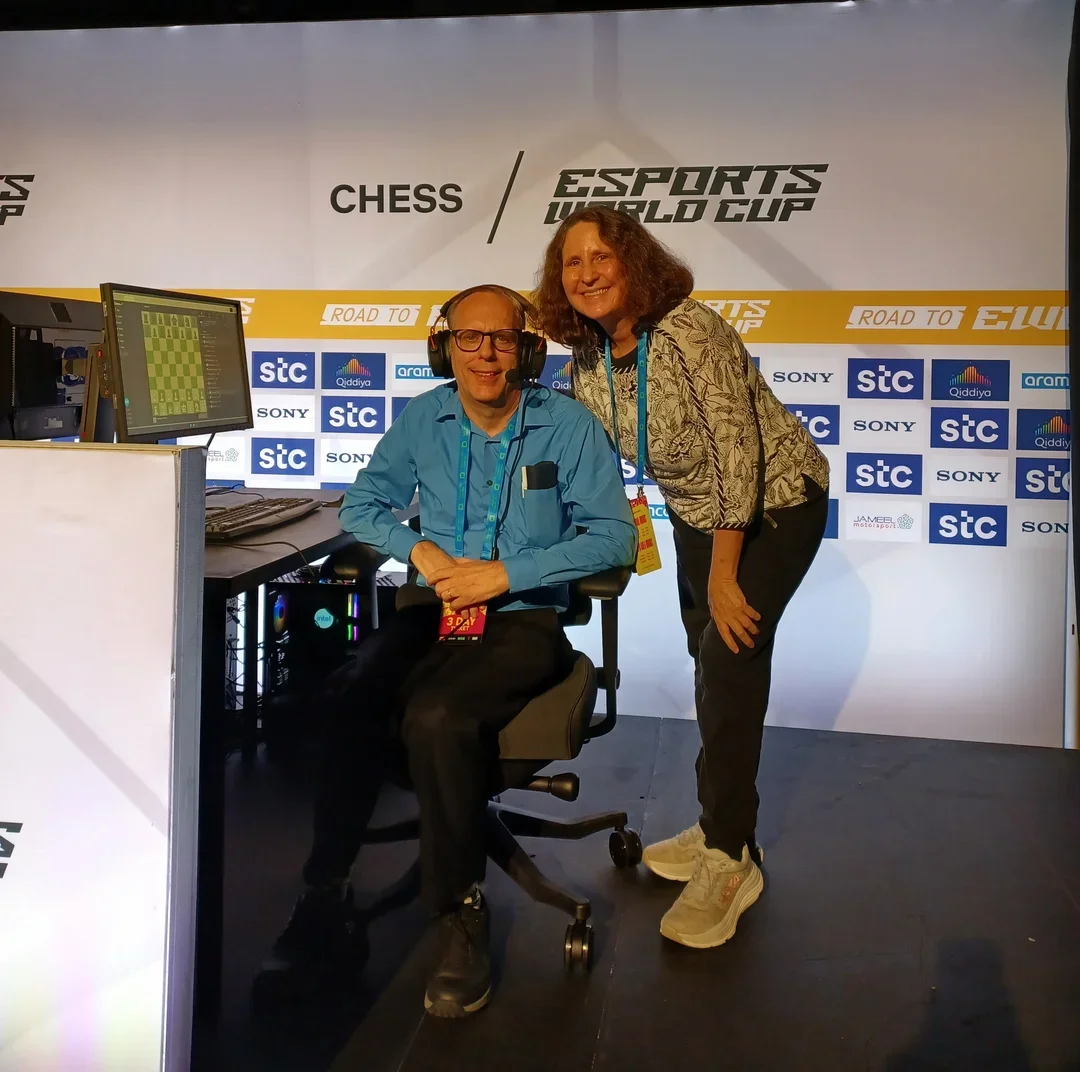
Both Doug and I were placed into this group, finishing third and fourth, respectively. Doug annotated his exciting game against Chithambaram, which can be replayed below:
I refused Goyal’s ninth-round draw offer, as my defeating her would allow Doug to tie for second place in Group C. Then, if tiebreaks went his way, Doug would qualify for one of the two playoff spots from Group C.
After I won, I found out that Doug had drawn in round 9. He finished with 6½/9, good for third place in Group C and for 9–12th overall. My winning round 9 moved me to 5½/9 and fourth place in Group C. Therefore, I tied for 13–16th overall.
GM Andrew Tang swept Group D, which was nine rounds long, with a perfect 9/9 score. Second place was NM Eric Kurtz with 7½/9.
Playoffs
The winners of Groups A, B, C, and D finished in that alphabetical group order in the playoffs. The Group A winner, GM Oleksandr Bortnyk, won the Grand Final and took first overall. The Group B winner, GM Aleksei Sarana, took second place. Each brought their own mouse rather than using a mouse provided by the organizer. The player briefing PowerPoint presentation stated, “EWC will provide PCs, Displays, Mouses and Keyboards. You are welcome to bring your own peripherals (mouses and keyboards) if you have any preferences.”
The Group C winner, Chithambaram, took third place. And the Group D winner, Tang, took fourth place. The playoff used a double-elimination format that is popular in other esports competitions and should be familiar to chess fans who have followed the American Cup.
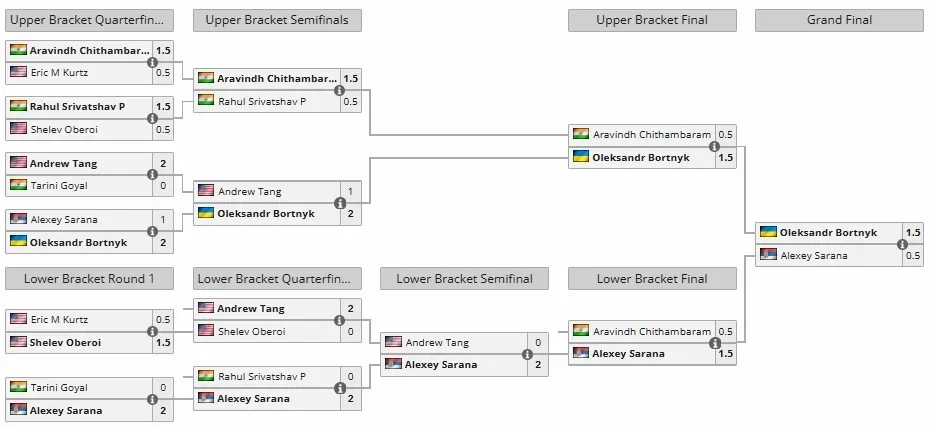
Bortnyk’s Upper Bracket Quarterfinals match against Sarana was the only first-round playoff match between two grandmasters. Fittingly, it was the only match of that round to go to tie-breaks, with Bortnyk winning on time in a queen endgame where Sarana had five pawns to Bortnyk’s zero in the final position.
Of the other Quarterfinals, Peddi’s win over Oberoi in their second game (after the NM held Peddi to a draw in game 1) was particularly entertaining:
In the next round, Bortnyk was again taken to tie-breaks, this time by Tang. White won all three games in this match, with Bortnyk’s tie-break proving decisive:
In the Upper Bracket Finals, Bortnyk capitalized on an early blunder by Chithambaram to win the first game, holding a solid draw in the second to book his spot in the Grand Final.
To earn his rematch against Bortnyk in the Grand Final, Sarana had to go through four additional rounds in the Lower Bracket. Sarana managed to sweep his first three rounds in the Lower Bracket, riding a six-game winning streak that included two wins over Peddi and two more wins over Tang, including this Catalan victory:
In the Lower Bracket Finals, Chithambaram held Sarana to a draw in their first game before Sarana managed to win on time in a drawn endgame.

After the aforementioned draw in their first game of the Grand Final, Bortnyk clinched victory by out-playing his opponent in a tense Sicilian middlegame:
After Bortnyk won the Grand Final, he asked the applauding crowd, “Where is my trophy?” There wasn’t a trophy, or an awards ceremony. But Bortnyk and Sarana posed for photos. They were told that their VISAs for their upcoming trip to the EWC in Riyadh, Saudi Arabia, would be prepared. And that they would receive their monetary prizes within one to two weeks, which is also good news for the other chess players who won prizes at DreamHack Dallas.
Special Guests
There were more than 900 special guests for DreamHack Dallas. Of the 16 special guests listed at the very top of this page, two are known for chess: WFM Alexandra Botez and Andrea Botez.
They took the world of Chess by storm, and now the Botez sisters are coming to #DHDallas to celebrate and spectate the Road to @EWC_EN Chess Tournament! ♟️
You’ll have two chances to catch the duo at their Meet & Greets:
1️⃣ Saturday, May 24 4:30PM
2️⃣ Sunday, May 25 1:00PM pic.twitter.com/orsEIvMkVy— DreamHack (@DreamHack) May 20, 2025
GL HF!
On the last slide of the player briefing PowerPoint presentation was “GL HF!,” which stands for “Good Luck, Have Fun!” Doug and I, along with our son William, had fun at DreamHack Dallas. Before Group C on Saturday, we attended a Women in Esports panel.
The Women in Gaming panel featuring @BonnieElvira, @missharvey, @larinhagoddess, @herculysee and Viki Rusyn was ah-mazing!
More to come soon pic.twitter.com/U7GDM4EFFR— Intel Gaming (@IntelGaming) May 24, 2025
After Group C, we attended a cosplay competition. The costumes and props were impressive! On Sunday, I met Tactical Gramma, who has made a career out of playing and streaming video games from her children’s basement.
Also on Sunday, I waited 50 minutes to meet the Botez sisters. Many people walked past me and the other people standing in line. Almost all passersby commented on the multiple tournament-style chess boards and the one giant chess set, equipment which Chess.com staff had placed in between the dark library-style area for computers and the well-lit stage.
Several passersby entered the Road to EWC area, which had chess on the left and StarCraft on the right, to play a few casual games of chess. While in line for the Botez sisters, some men discussed the DrLupo cheating scandal. It was fun to see and hear DreamHack Dallas attendees engage with chess.
Luis Salinas Memorial 80th Annual Texas State and Amateur Championships
The Luis Salinas Memorial 80th Annual Texas State and Amateur Championships was announced months before DreamHack Dallas chess. Played over-the-board at the Vista, a shopping mall 22 miles north of the Kay Bailey Hutchison Convention Center, it attracted UTD’s new coach GM Mikhail Antipov and other Texas luminaries, such as GM Jeffery Xiong (ranked #97 among active players in the world).
As of Wednesday, May 21st, when DreamHack Dallas had 37 advance entries, the Luis Salinas Memorial 80th Annual Texas State and Amateur Championships had 114 advance entrants. It ended up with 133 entries. Antipov won the Championship section with Xiong finishing in second place (link to crosstable). It was broadcast on lichess.org.
FM Lucius Melillo played in Group B on Friday at DreamHack Dallas. He did not qualify for the Sunday playoffs but won $125 for tying for 13–16 places. Melillo then played the three-day schedule (which began on Saturday, May 24) of the Texas State Championship.
Melillo was exceptional in attending both DreamHack Dallas and the Texas State Championship. Having both chess tournaments geographically close to each other and on similar dates probably hurt attendance.
Categories
Archives
- December 2025 (4)
- November 2025 (29)
- October 2025 (39)
- September 2025 (27)
- August 2025 (29)
- July 2025 (43)
- June 2025 (25)
- May 2025 (24)
- April 2025 (29)
- March 2025 (29)
- February 2025 (20)
- January 2025 (24)
- December 2024 (34)
- November 2024 (18)
- October 2024 (35)
- September 2024 (23)
- August 2024 (27)
- July 2024 (44)
- June 2024 (27)
- May 2024 (31)
- April 2024 (51)
- March 2024 (34)
- February 2024 (25)
- January 2024 (26)
- December 2023 (29)
- November 2023 (26)
- October 2023 (37)
- September 2023 (27)
- August 2023 (37)
- July 2023 (47)
- June 2023 (33)
- May 2023 (37)
- April 2023 (45)
- March 2023 (37)
- February 2023 (28)
- January 2023 (31)
- December 2022 (23)
- November 2022 (32)
- October 2022 (31)
- September 2022 (19)
- August 2022 (39)
- July 2022 (32)
- June 2022 (35)
- May 2022 (21)
- April 2022 (31)
- March 2022 (33)
- February 2022 (21)
- January 2022 (27)
- December 2021 (36)
- November 2021 (34)
- October 2021 (25)
- September 2021 (25)
- August 2021 (41)
- July 2021 (36)
- June 2021 (29)
- May 2021 (29)
- April 2021 (31)
- March 2021 (33)
- February 2021 (28)
- January 2021 (29)
- December 2020 (38)
- November 2020 (40)
- October 2020 (41)
- September 2020 (35)
- August 2020 (38)
- July 2020 (36)
- June 2020 (46)
- May 2020 (42)
- April 2020 (37)
- March 2020 (60)
- February 2020 (38)
- January 2020 (45)
- December 2019 (34)
- November 2019 (35)
- October 2019 (42)
- September 2019 (45)
- August 2019 (56)
- July 2019 (44)
- June 2019 (35)
- May 2019 (40)
- April 2019 (48)
- March 2019 (61)
- February 2019 (39)
- January 2019 (30)
- December 2018 (29)
- November 2018 (51)
- October 2018 (45)
- September 2018 (29)
- August 2018 (49)
- July 2018 (35)
- June 2018 (31)
- May 2018 (39)
- April 2018 (31)
- March 2018 (26)
- February 2018 (33)
- January 2018 (30)
- December 2017 (26)
- November 2017 (24)
- October 2017 (30)
- September 2017 (30)
- August 2017 (31)
- July 2017 (28)
- June 2017 (32)
- May 2017 (26)
- April 2017 (37)
- March 2017 (28)
- February 2017 (30)
- January 2017 (27)
- December 2016 (29)
- November 2016 (24)
- October 2016 (32)
- September 2016 (31)
- August 2016 (27)
- July 2016 (24)
- June 2016 (26)
- May 2016 (19)
- April 2016 (30)
- March 2016 (36)
- February 2016 (28)
- January 2016 (32)
- December 2015 (26)
- November 2015 (23)
- October 2015 (16)
- September 2015 (28)
- August 2015 (28)
- July 2015 (6)
- June 2015 (1)
- May 2015 (2)
- April 2015 (1)
- February 2015 (3)
- January 2015 (1)
- December 2014 (1)
- July 2010 (1)
- October 1991 (1)
- August 1989 (1)
- January 1988 (1)
- December 1983 (1)







